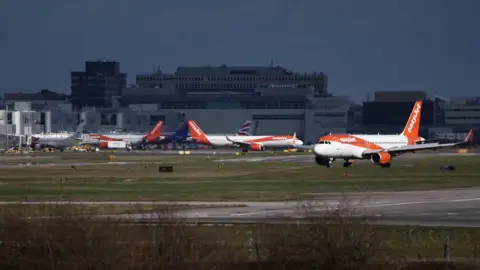Gatwick Airport has taken a significant step towards addressing noise pollution generated by aircraft operations by agreeing to imposing stricter limits on plane noise. This decision comes in the wake of the UK government’s indication of its support for the airport’s plans to utilize its second runway, a project that has been a topic of contention in discussions related to environmental impact and community well-being.
In a statement released recently, Gatwick Airport acknowledged the government’s recent approval regarding the second runway and provided an outline of what it refers to as an ‘improved noise scheme’. The Transport Secretary, Heidi Alexander, expressed her inclination to permit the operation of the second runway in a letter last month, prompting the airport to respond proactively. Their commitment to better noise management reflects an ongoing acknowledgment of community concerns and the impact of increased flight operations on the surrounding areas.
Part of Gatwick’s plan includes a notable target of ensuring that at least 54% of passengers use public transport to access the airport before the Northern Runway can be operationalized. Achieving this ambitious target requires formidable logistical support, and Gatwick has called upon various stakeholders, including the Department for Transport, to collaborate in meeting this objective. A vital aspect of the improvement strategy highlighted by Gatwick includes the reinstatement of the full Gatwick Express train service, which would facilitate easier access for travelers while reinforcing public transport usage.
In the event that the airport fails to meet the specified public transport target, Gatwick has proposed an alternative contingency plan that would involve adhering to an alternative limit concerning vehicle traffic. If neither transportation goal is achieved, the operationalization of the second runway would face delays until £350 million worth of necessary road enhancements are completed, thus potentially affecting travel and transport dynamics in the surrounding area.
Gatwick Airport has emphasized the need for collaboration with various entities to ensure the successful implementation of these conditions, as they aim to minimize the adverse impacts associated with increased air traffic. The airport has plans to advance discussions regarding sustainability design measures intended to diminish emissions, showing a conscientious effort to align operational growth with environmental preservation.
Highlighting the significance of this project, Stewart Wingate, the CEO of Gatwick Airport, remarked, “This project represents a £2.2 billion investment, fully funded by our shareholders, and it is essential that any planning conditions enable us to make full use of the Northern Runway.” He expressed confidence that their revised proposals would not only help the airport accommodate growing passenger demand but also address critical concerns that have been outlined by the Secretary of State, particularly regarding noise and environmental implications.
The final verdict on Gatwick’s proposal and its additional noise controls is expected from the Secretary of State by 27 October, representing an important deadline in the airport’s plans for expansion and community engagement moving forward. Such decisions are crucial, given the balancing act between expanding infrastructural capabilities and maintaining the trust and support of the local communities affected by airport operations.
With this development in mind, stakeholders in the transportation sector and local residents alike are keeping a close watch on the outcome of this decision, as it will undoubtedly shape the future landscape of Gatwick and its role in air travel within the UK.











